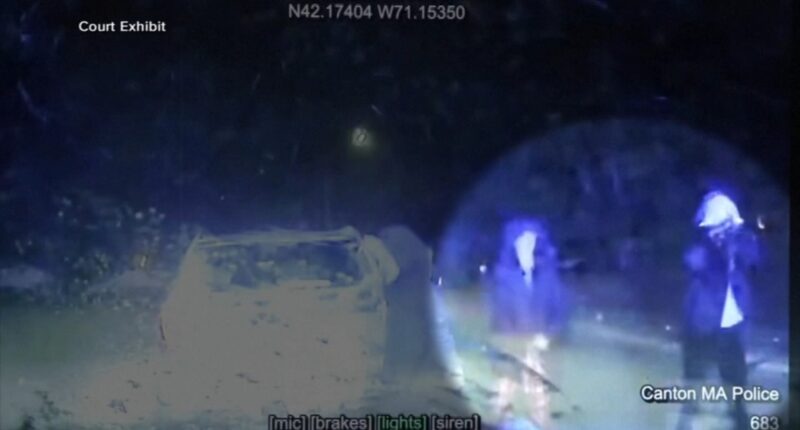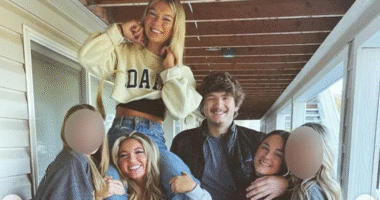The prosecution wrapped up its presentation in the second trial of Karen Read after approximately one month of testimony. During the trial, evidence from the crime scene was highlighted, along with accounts from witnesses who reported hearing the defendant confess, saying “I hit him,” in relation to the death of her boyfriend, a Boston police officer.
Karen Read, aged 45, stands accused of fatally running over her boyfriend, John O’Keefe, with her SUV. The incident occurred on a snowy night when she dropped him off at a party at another officer’s residence in January 2022. Read’s defense team claims she is a victim of a police conspiracy, alleging that someone inside the house where the party took place is responsible for O’Keefe’s death.
Following a mistrial in the previous year, the ongoing second trial has garnered significant media coverage and has even become the subject of a documentary series on Hulu. The charges against Read in the second trial include second-degree murder, manslaughter, and leaving the scene of the crime. The proceedings of this trial bear resemblance to the initial trial. In the event of a conviction for second-degree murder, Read could potentially face a life sentence behind bars.
The video in the player above is from an earlier report.
Simplified approach
The prosecution, led this time by Hank Brennan, has taken a more streamlined, focused approach.
Unlike the first trial where witness after witness undermined the prosecution’s case, Brennan did everything to avoid those mistakes. Most significantly, he refrained from putting Michael Proctor, the lead investigator in the case, on the stand.
Proctor was fired in March after a disciplinary board found he sent sexist and crude text messages about Read to his family and colleagues. His testimony played a key role in the first trial. Defense attorneys used his text messages to attempt to show Proctor was biased and ignored the possibility of other suspects.
Brennan also didn’t put Brian Albert, the Boston officer who owned the house where O’Keefe’s body was found, on the stand. He also passed on putting on Brian Higgins, a federal agent who had exchanged flirty texts with Read, on the stand.
All three testified in the first trial and could be called by the defense as it seeks to show O’Keefe was beaten at the house party hosted by Albert and left outside to die.
Read’s attorney, Alan Jackson, still managed to raise concerns about Higgins and Proctor.
During the cross-examination of Massachusetts State Police Sgt. Yuriy Bukhenik, he made him read all the flirtatious texts between Higgins and Read.
Jackson also brought up a text message chain with Bukhenik in which Proctor said, “I hate that man, I truly hate him” about David Yannetti, an attorney for Read.
Stick to the evidence
Broken pieces of Read’s taillight. A broken cocktail glass. Read’s words the scene.
Prosecutors have spent much of the trial building their case through evidence from the scene. Like before, they started by introducing several law enforcement witnesses who were among the first responders and recalled hearing Read repeatedly say “I hit him” after she found O’Keefe.
They also played several clips of interviews Read has done since the first trial, in which she talked about how much she drank and made comments suggesting she knew what she did. She also talked about pulling a piece of glass from O’Keefe’s nose.
“Could I have clipped him? Could I have tapped him in the knee and incapacitated him?” she said during an interview for a documentary on the case. “He didn’t look mortally wounded, as far as I could see” but “could I have done something that knocked him out and in his drunkenness and in the cold didn’t come to again.”
Prosecutors called a neurosurgeon who testified O’Keefe suffered a “classic blunt trauma injury” associated with falling backward and hitting the back of his head.
Prosecutors also showed jurors pieces of the Read’s broken taillight, which they say was damaged when she hit O’Keefe. The defense argues the taillight was damaged later when she was backing out of O’Keefe’s house and hit O’Keefe’s car.
Prosecutors also introduced evidence of a broken cocktail glass, found at the scene, which they said O’Keefe was holding when Read backed into him.
DNA evidence played a part
Andre Porto, a forensic scientist who works in the DNA unit of the Massachusetts State Police Crime Lab, detailed various items he tested, including the broken rear taillight and pieces of a broken cocktail glass found in in the yard. Only O’Keefe was a likely match for both.
Porto found three DNA contributors but only O’Keefe was a likely match. He also tested DNA from parts of a broken cocktail glass found in the yard and only O’Keefe was seen as a likely match. Porto also tested a hair found on the taillight.
Later in the trial, analyst Karl Miyasako of Bode Technology testified that tests of the hair sample taken from Read’s vehicle found a mitochondrial DNA match to O’Keefe. He said that means the DNA could be a match to O’Keefe or any one of his maternal relatives.
What’s next for defense
The trial could easily continue several more weeks as Read’s defense team makes its case. Read has said the defense’s case will be “more robust” this time. It listed over 90 witnesses who could testify.
“I’m anxious for everyone to learn what we know,” she said last week.
Read’s defense has vigorously questioned the prosecution’s witnesses and called into question evidence presented about O’Keefe’s death. During opening statements in April, Brennan said Read “admitted what she did that night” and pointed to a television interview in which Read said “could I have clipped him?” about O’Keefe’s death.
Copyright © 2025 by The Associated Press. All Rights Reserved.

















